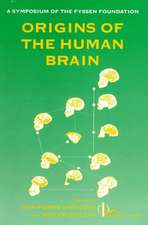Modulation of Host Gene Expression and Innate Immunity by Viruses
Editat de Jean-Pierre Changeux, Peter Paleseen Limba Engleză Hardback – 30 noi 2004
Infection of a naïve (non-immune) host with a virus elicits an immediate response which results in a cascade of changes in the host, including an interferon response (innate immunity). The outcome of this interaction is influenced by the genes of the virus as well as the genes of the host. Interestingly, different viruses do it in different ways. Not only is there a plethora of mechanisms used by the invading organisms, but the host has also evolved a great variety of redundant and robust countermeasures. This interplay of host and virus represents one of the most significant frontiers in biology today. A clearer understanding of the mechanisms involved will arm us with better strategies to deal with viruses, including emerging pathogens and potential bioterrorism agents. This book is sure to benefit students, scientists, and physicians working in the areas of virology, immunology, microbiology, and infectious diseases. Pharmaceutical industry professionals will also find interest in this illuminating look into virus/host interactions.
| Toate formatele și edițiile | Preț | Express |
|---|---|---|
| Paperback (1) | 945.62 lei 6-8 săpt. | |
| SPRINGER NETHERLANDS – 19 oct 2010 | 945.62 lei 6-8 săpt. | |
| Hardback (1) | 951.77 lei 6-8 săpt. | |
| SPRINGER NETHERLANDS – 30 noi 2004 | 951.77 lei 6-8 săpt. |
Preț: 951.77 lei
Preț vechi: 1160.70 lei
-18% Nou
Puncte Express: 1428
Preț estimativ în valută:
182.15€ • 189.46$ • 150.37£
182.15€ • 189.46$ • 150.37£
Carte tipărită la comandă
Livrare economică 15-29 aprilie
Preluare comenzi: 021 569.72.76
Specificații
ISBN-13: 9781402032417
ISBN-10: 1402032412
Pagini: 318
Ilustrații: XIV, 304 p.
Dimensiuni: 156 x 232 x 19 mm
Greutate: 0.63 kg
Ediția:2005
Editura: SPRINGER NETHERLANDS
Colecția Springer
Locul publicării:Dordrecht, Netherlands
ISBN-10: 1402032412
Pagini: 318
Ilustrații: XIV, 304 p.
Dimensiuni: 156 x 232 x 19 mm
Greutate: 0.63 kg
Ediția:2005
Editura: SPRINGER NETHERLANDS
Colecția Springer
Locul publicării:Dordrecht, Netherlands
Public țintă
Professional/practitionerCuprins
Viruses and the Innate Immune System.- How Viruses Elicit Interferon Production.- Genes Modulated by Interferons and Double-Stranded RNA.- Immunoevasive Strategies: Host and Virus.- Interferon Antagonists of Influenza Viruses.- The Anti-Interferon Mechanisms of Paramyxoviruses.- The Strategy of Conquest.- Immunomodulation by Poxviruses.- Interferon Antagonists Encoded by Emerging RNA Viruses.- Viral Pathogenesis and Toll-Like Receptors.- Digesting Oneself and Digesting Microbes.- Genetic Variation in Host Defenses and Viral Infections.
Recenzii
While the molecular mechanisms of antibody production and diversity and of cellular specific immune responses have been studied since many decades, the actions of viruses blocking and modifying the innate immune system, i.e. mainly the interferon (IFN) response and its various signaling pathways, have been recognized and studied in more detail only during the last 10-15 years. Viruses can counteract defense strategies of infected cells, and specific proteins of many viruses were found to act as IFN antagonists.
In this book a number of groups leading this area of research have presented reviews and updates of their research. In the introductory chapter M Shaw and P Palese review the IFN signaling pathways and provide a comprehensive list of virus-encoded proteins that target different components of the pathways of the IFN response. It is then reviewed how viruses elicit the IFN production (DE Levy and IJ Marié), how IFN regulatory genes are induced by viruses (group of GC Sen), how viruses have ‘learned’ to evade immune mechanisms, interfering with MHC mediated antigen presentation, blockage of apoptosis, mimicking of cytokines and cellular receptors, or by direct infection of immune cells (group of HL Ploegh). In additional chapters, the virus-encoded IFN antagonists of particular viruses are described, such as of influenzaviruses (A Garcia-Sastre), paramyxoviruses (group of RE Randall), herpes simplex virus (SJ Advani and B Roizman), poxviruses (JB Johnston and G McFadden), filoviruses, bunyaviruses and flaviviruses (CF Basler). For poxviruses, the mechanisms of molecular mimikry, i.e. viral proteins binding to cytokines or cytokine receptors, are of particular interest. A new area of research is the involvement of toll-like receptors in the activation of pathways of the innate immune response and of their interaction with viral proteins (SR Ross). Autophagy is a protective mechanism of mammalian cells that can be targeted by viralvirulence gene products (group of B Levine). Finally, the ways in which the genetic variation of hosts influences the susceptibility to viral infections is reviewed in a short chapter with particular attention to infection with HIV (E Choi and S Chanock).
There is minimal overlap between the different chapters, and the references are very up-to-date (a considerable number of them published in 2004). In several chapters the years of publication of references are omitted for no obvious reasons. Some chapters would have benefited from the presence of illustrations and tables.
This book is an excellent, up-to-date reference on a relatively young area of research in which virology, cellular biology and molecular pathogenesis govern the principles of coinvestigation. Thus, the book will be of great interest to virologists, molecular immunologists and biologists, and biochemists but also to clinical pharmacologists in the long-term search for new antiviral agents.
Gif-sur-Yvette/Cambridge,
Ulrich Desselberger
In this book a number of groups leading this area of research have presented reviews and updates of their research. In the introductory chapter M Shaw and P Palese review the IFN signaling pathways and provide a comprehensive list of virus-encoded proteins that target different components of the pathways of the IFN response. It is then reviewed how viruses elicit the IFN production (DE Levy and IJ Marié), how IFN regulatory genes are induced by viruses (group of GC Sen), how viruses have ‘learned’ to evade immune mechanisms, interfering with MHC mediated antigen presentation, blockage of apoptosis, mimicking of cytokines and cellular receptors, or by direct infection of immune cells (group of HL Ploegh). In additional chapters, the virus-encoded IFN antagonists of particular viruses are described, such as of influenzaviruses (A Garcia-Sastre), paramyxoviruses (group of RE Randall), herpes simplex virus (SJ Advani and B Roizman), poxviruses (JB Johnston and G McFadden), filoviruses, bunyaviruses and flaviviruses (CF Basler). For poxviruses, the mechanisms of molecular mimikry, i.e. viral proteins binding to cytokines or cytokine receptors, are of particular interest. A new area of research is the involvement of toll-like receptors in the activation of pathways of the innate immune response and of their interaction with viral proteins (SR Ross). Autophagy is a protective mechanism of mammalian cells that can be targeted by viralvirulence gene products (group of B Levine). Finally, the ways in which the genetic variation of hosts influences the susceptibility to viral infections is reviewed in a short chapter with particular attention to infection with HIV (E Choi and S Chanock).
There is minimal overlap between the different chapters, and the references are very up-to-date (a considerable number of them published in 2004). In several chapters the years of publication of references are omitted for no obvious reasons. Some chapters would have benefited from the presence of illustrations and tables.
This book is an excellent, up-to-date reference on a relatively young area of research in which virology, cellular biology and molecular pathogenesis govern the principles of coinvestigation. Thus, the book will be of great interest to virologists, molecular immunologists and biologists, and biochemists but also to clinical pharmacologists in the long-term search for new antiviral agents.
Gif-sur-Yvette/Cambridge,
Ulrich Desselberger
Caracteristici
The interplay of host and virus represents one of the most significant frontiers in biology today Provides a clearer understanding of the mechanisms involved to arm us with better strategies to deal with viruses, including emerging pathogens and potential bioterrorism agents









